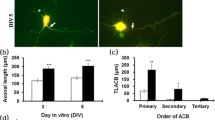Abstract
Increasing evidences implicate impairment of axonal integrity in mechanisms underlying neurodegenerative disorders. Beta-boswellic acid (BBA) is the major component of Boswellia serrata gum. This resin has long been used in Ayurveda (India’s traditional medicine) to prevent amnesia. In this study, the effect of BBA was examined on neurites outgrowth and branching as well as on polymerization dynamics of tubulin. The morphometric parameters (axonal length and neuritis branching) were examined microscopically after treating the hippocampal cells with BBA. Also the assembly process of tubulin was assessed using UV/V is spectrophotometer through following of absorbance at 350 nm. The results revealed that BBA could significantly enhance neurite outgrowth, branching, and tubulin polymerization dynamics. The obtained results suggest that enhancing effect of BBA on microtubule polymerization kinetics might be the origin of increasing axonal outgrowth and branching.




Similar content being viewed by others
References
Kalil K, Szebenyi G, Dent EW (2000) Common mechanisms underlying growth cone guidance and axon branching. J Neurobiol 44:145–158
Desai A, Mitchison TJ (1997) Microtubule polymerization dynamics. Annu Rev Cell Dev Biol 13:83–117
Nelson R (2005) Microtubule-stabilising drugs may be therapeutic in AD. Lancet Neurol 4:83–84
Ngwalali PM, Yonemitsu K, Kibayashi K et al (2002) Neuropathological diagnosis of Alzheimer’s disease in forensic autopsy of elderly persons with fatal accident. Leg Med 4:223–231
Gómez-Isla T, Hollister R, West H et al (1997) Neuronal loss correlates with but exceeds neurofibrillary tangles in Alzheimer’s disease. Ann Neurol 41:17–24
Sergeant N, Bretteville A, Hamdane M et al (2008) Biochemistry of tau in Alzheimer’s disease and related neurological disorders. Expert Rev Proteomics 5:207–224
Rapoport M, Dawson HN, Binder LI et al (2002) Tau is essential to beta-amyloid-induced neurotoxicity. Proc Natl Acad Sci USA 99:6364–6369
Wahrle SE, Jiang H, Parsadanian M et al (2005) Deletion of Abca1 increases Abeta deposition in the PDAPP transgenic mouse model of Alzheimer disease. J Biol Chem 280:43236–43242
Nakayama T, Sawada T (2002) Involvement of microtubule integrity in memory impairment caused by colchicines. Pharmacol Biochem Behav 71:119–138
Lee VM, Daughenbaugh R, Trojanowski JQ (1994) Microtubule stabilizing drugs for the treatment of Alzheimer’s disease. Neurobiol Aging 15:S87–589
Manyam BV (1991) Dementia in Ayurveda. J Altern Complement Med 5:81–88
Mishra L, Singh BB, Dagenais S (2001) Healthcare and disease management in Ayurveda. Altern Ther Health Med 7:44–50
Etzel R (1996) Special extract of Boswellia serrata (H15) in the treatment of rheumatoid arthritis. Phytomedicine 3:67–70
Ammon HP, Mack T, Singh GB et al (1991) Inhibition of leukotriene B4 formation in rat peritoneal neutrophils by an ethanolic extract of the gum resin exudate of Boswellia serrata. Planta Med 57:203–207
Jauch J, Bergmann J (2003) An efficient method for the large-scale preparation of 3-O-acetyl-11-oxo-β-boswellic acid and other boswellic acids. Eur J Org Chem 24:4752–4756
Montanari T, Bevilacqua E (2002) Effect of Maytenus ilicifolia Mart on pregnant mice. Contraception 65:171–175
Goslin K, Banker G (1991) Rat hippocampal neurons in low-density culture. In: Culturing nerve cells. MIT Press, Cambridge, pp 251–281
Ray J, Peterson DA, Schinstine M et al (1993) Proliferation, differentiation, and long-term culture of primary hippocampal neurons. Proc Natl Acad Sci 90:3602–3606
Fletcher TL, Cameron P, De Camilli P et al (1991) The distribution of synapsin I and synaptophysin in hippocampal neurons developing in culture. J Neurosci 11:1617–1626
Lepekhin EA, Walmod PS, Berezin A et al (2001) Evaluation of cell morphology. Methods Mol Biol 161:85–100
Weingarten MD, Lockwood AH, Hwo SY et al (1975) A protein factor essential for microtubule assembly. Proc Natl Acad Sci 72:1852–1862
Laemmli UK (1970) Cleavage of structural proteins during the assembly of the head of bacteriophage T4. Nature 227:680–685
Bradford MM (1976) A rapid and sensitive method for the quantitation of microgram quantities of protein utilizing the principle of protein-dye binding. Anal Biochem 72:248–254
Tseng HC, Graves DJ (1998) Natural methylamine osmolytes, trimethylamine N-oxide and betaine, increase tau-induced polymerization of microtubules. Biochem Biophys Res Commun 250:726–730
Bass PW (1997) Microtubules and axonal growth. Curr Opin Cell Biol 9:29–36
Wenqian Y, Matthew J, Schwei W et al (1996) Microtubule transport and assembly during axon growth. J Biol Chem 133:151–157
Nogales E (1999) A structural view of microtubule dynamics. Cell Mol Life Sci 56:133–142
Detrich HW, Jordan MA, Wilson L et al (1985) Mechanism of microtubule assembly, changes in polymer structure and organization during assembly of sea urchin egg tubulin. J Biol Chem 260:9479–9490
Daniels MP (1972) Colchicine inhibition of nerve fiber formation in vitro. J Cell Biol 53:164–176
Yamada KM, Spooner BS, Wessells NK (1971) Ultrastructure and function of growth cones and axons of cultured nerve cells. J Cell Biol 49:614–635
Bentley D, Toroian RA (1986) Disoriented pathfinding by pioneer neuron growth cones deprived of filopodia by cytochalasin treatment. Nature 323:712–715
Acknowledgments
We would like to extend our special thanks to Prof. Thomas Simmet from Ulm University for providing BBA. We also thank Ms. Hatami, Administrator of Center for Microscopy and Imaging in the Institute of Biochemistry and Biophysics (IBB), the University of Tehran, for her kind efforts.
Author information
Authors and Affiliations
Corresponding author
Rights and permissions
About this article
Cite this article
Karima, O., Riazi, G., Yousefi, R. et al. The enhancement effect of beta-boswellic acid on hippocampal neurites outgrowth and branching (an in vitro study). Neurol Sci 31, 315–320 (2010). https://doi.org/10.1007/s10072-010-0220-x
Received:
Accepted:
Published:
Issue Date:
DOI: https://doi.org/10.1007/s10072-010-0220-x




